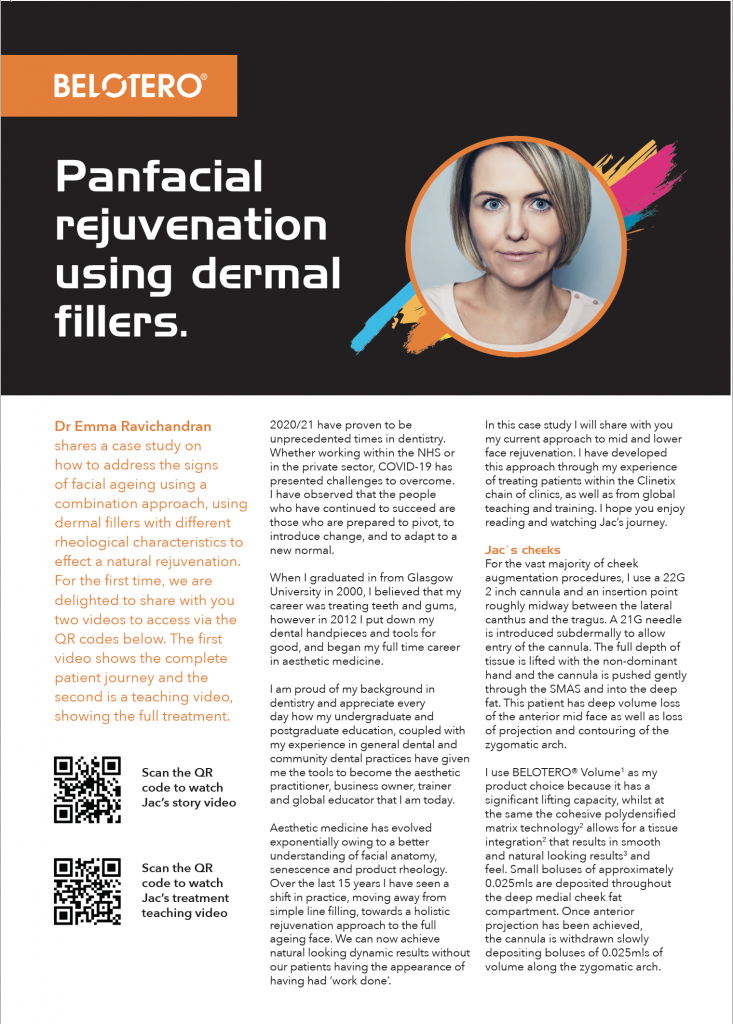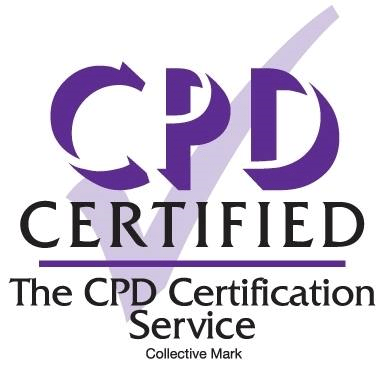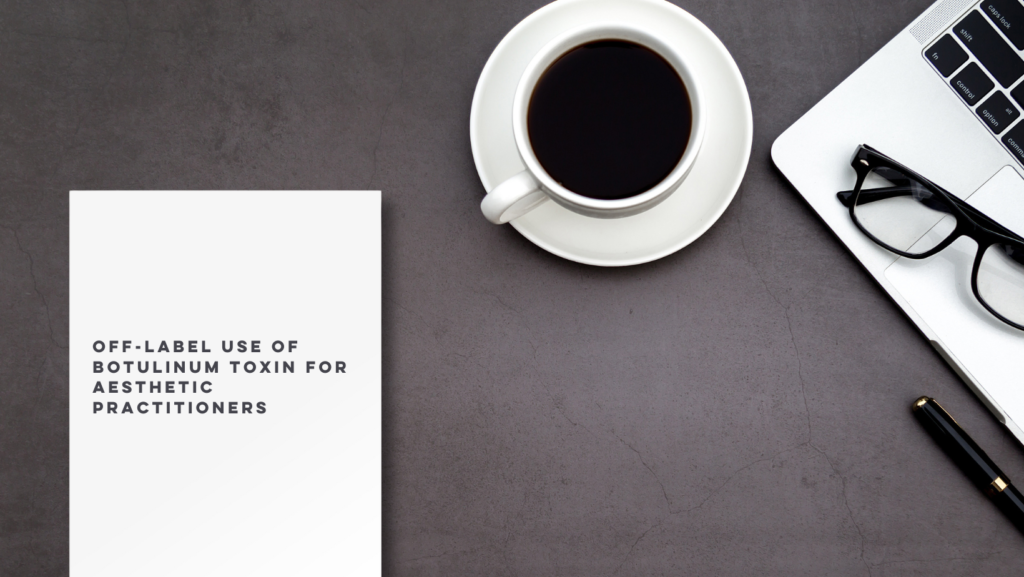ATA Director Dr Emma Ravichandran BDS.MFDS recently shared a patient case study on behalf of Merz Aesthetics on how to address the signs of facial ageing using a combination approach.
Panfacial Rejuvenation using dermal fillers


Dr Emma Ravichandran shares a case study on how to address the signs of facial ageing using a combination approach, using dermal fillers with different rheological characteristics to effect a natural rejuvenation. For the first time, we are delighted to share with you two videos to access via the QR codes below. The first video shows the complete patient journey and the second is a teaching video, showing the full treatment.
2020/21 have proven to be unprecedented times in dentistry. Whether working within the NHS or in the private sector, COVID-19 has presented challenges to overcome. I have observed that the people who have continued to succeed are those who are prepared to pivot, to introduce change, and to adapt to a new normal.
When I graduated in from Glasgow University in 2000, I believed that my career was treating teeth and gums, however in 2012 I put down my dental handpieces and tools for good, and began my full time career in aesthetic medicine.
I am proud of my background in dentistry and appreciate every day how my undergraduate and postgraduate education, coupled with my experience in general dental and community dental practices have given me the tools to become the aesthetic practitioner, business owner, trainer and global educator that I am today.
Aesthetic medicine has evolved exponentially owing to a better understanding of facial anatomy, senescence and product rheology. Over the last 15 years I have seen a shift in practice, moving away from simple line filling, towards a holistic rejuvenation approach to the full ageing face. We can now achieve natural looking dynamic results without our patients having the appearance of having had ‘work done’.
In this case study I will share with you my current approach to mid and lower face rejuvenation. I have developed this approach through my experience of treating patients within the Clinetix chain of clinics, as well as from global teaching and training. I hope you enjoy reading and watching Jac’s journey.
Jac’s cheeks
For the vast majority of cheek augmentation procedures, I use a 22G 2 inch cannula and an insertion point roughly midway between the lateral canthus and the tragus. A 21G needle is introduced subdermally to allow entry of the cannula. The full depth of tissue is lifted with the non-dominant hand and the cannula is pushed gently through the SMAS and into the deep fat. This patient has deep volume loss of the anterior mid face as well as loss of projection and contouring of the zygomatic arch.
I use BELOTERO® Volume(1) as my product choice because it has a significant lifting capacity, whilst at the same the cohesive polydensified matrix technology(2) allows for a tissue integration(2) that results in smooth and natural looking results(3) and feel. Small boluses of approximately 0.025mls are deposited throughout the deep medial cheek fat compartment. Once anterior projection has been achieved, the cannula is withdrawn slowly depositing boluses of 0.025mls of volume along the zygomatic arch.
Jac’s tear trough
A 21G needle is introduced subdermally to allow entry of the 22G 2’’ cannula at the lower anterior cheek. The tissues are lifted with the non-dominant hand and the cannula is advanced through the SMAS. A pop, then a loss of resistance is felt as the cannula enters the deep fat. The cannula can then be advanced to the medial part of the tear trough. Small boluses of 0.025mls of BELOTERO® Balance(4) are deposited before the cannula is positioned more laterally along the tear trough. Small boluses revolumise the tear trough deformity. A total of 0.5ml of BELOTERO® Balance(4) has been used on each side to treat this patient’s tear troughs.
Jac’s chin
An unprimed 27G 0.5 inch needle is placed at a 45 degree angle to the skin between the Pogonion and Menton of the chin. Product placement here will both project and round the chin. I am using BELOTERO® Volume(1) as my product choice. The needle is advanced until contact with the bony chin is made.
A 5 second aspiration is performed.
A 0.4ml bolus of BELOTERO® Volume(1) is deposited slowly. The process is repeated for the contralateral side of the chin. The direct bolus technique with needle has the advantage of accuracy of product placement.
Jac’s marionette area
A 23G trochar needle placed through the dermis at the pre jowl region allows the entry of a primed 25G 1.5 inch cannula into the subcutaneous fat.
The cannula is gently advanced through the fat as close as possible to the dermis. The cannula is moved backwards and forwards throughout the whole area to be revolumised. Small retrograde strands of product are laid down next to one another. Gentle cannula movements make this a comfortable treatment with a low risk of bruising. I use BELOTERO® Intense(5) in this highly mobile region because of its high elasticity, yet natural integration profile. The multiple thin strands of product can be blended together to give a natural lifting, even result(6).
Summary
Jac had a total of 5mls of BELOTERO® placed in both the deep and superficial fat of the mid and lower face. There was minimal immediate post operative swelling and no bruising. Post operative instructions were given to the patient and she was reviewed at the clinic 2 weeks after treatment. Before and 2 weeks post treatment photographs show global and natural rejuvenation. I would expect this treatment to last 12-18 months. As you can see from the patient’s journey, she is delighted with the results and her expectations of the treatment were exceeded.
Full facial rejuvenation requires advanced training. It combines an understanding of science and anatomy with passion and art. Facial aesthetic treatment complements aesthetic dentistry beautifully, offering patient’s a comprehensive treatment plan for health and rejuvenation. If you would like information on introductory, advanced or master classes in aesthetic medicine, please email us at enquiries@ataglasgow.co.uk or visit our website at ataglasgow.co.uk.
Visit merzwebinars.com for our latest webinars
References
1 IFU BELOTERO® Volume Lido.
2 Micheels P, Besse S, Sarazin D, et al. Ultrasound and Histologic Examination after Subcutaneous Injection of Two Volumizing Hyaluronic Acid Fillers: A Preliminary Study. Plast Reconstr Surg Glob Open. 2017;5(2):e1222.
3 Micheels P et al. Thérapeutiques en Dermato-Vénérologie, Sep. 2014 (Mensuel 235, Cahier).
4 IFU BELOTERO® Balance Lido.
5 BELOTERO® Intense.
6 Sundaram & Fagien 2015_CPM HA for fine lines.





